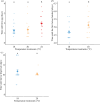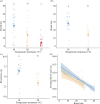The effect of experimental warming on reproductive performance and parental care in the burying beetle Nicrophorus nepalensis
- PMID: 39386988
- PMCID: PMC11461049
- DOI: 10.1098/rsos.240653
The effect of experimental warming on reproductive performance and parental care in the burying beetle Nicrophorus nepalensis
Abstract
Rising temperatures can adversely affect parental care and reproductive performance across a range of taxa. However, the warming impact is contingent upon understanding how temperature affects the spectrum of parental behaviours and their interplay. Here, we assessed how temperature affects parental care and reproductive success in the burying beetle, Nicrophorus nepalensis, which exhibits complex parental care behaviours. We exposed breeding pairs of N. nepalensis, to three temperature regimes (18°C, 20°C and 22°C) and assessed changes in parental care, and the subsequent development and growth of their offspring. Our findings show that 22°C disrupts carcass nest building by the parents and results in smaller clutches. Moreover, no eggs successfully hatched in the 22°C treatment. A milder increase to 20°C did not affect the hatching rate but resulted in smaller broods and lighter offspring, even when considering brood size, suggesting a change in post-hatching care quality. Our research suggests that warming may weakly affect parental care but has strong detrimental effects on offspring performance. These findings highlight the necessity of investigating the effect of ambient temperature across a diversity of traits and behaviours and across a range of life-history stages to fully assess species vulnerability in the face of future climate change.
Keywords: climate change; life-history traits; nest construction; reproductive success.
© 2024 The Author(s).
Conflict of interest statement
We declare we have no competing interests.
Figures



Similar articles
-
Carcass size, not source or taxon, dictates breeding performance and carcass use in a burying beetle.R Soc Open Sci. 2024 Oct 30;11(10):241265. doi: 10.1098/rsos.241265. eCollection 2024 Oct. R Soc Open Sci. 2024. PMID: 39479237 Free PMC article.
-
Heat stress effects on offspring compound across parental care.Proc Biol Sci. 2025 Mar;292(2042):20250026. doi: 10.1098/rspb.2025.0026. Epub 2025 Mar 5. Proc Biol Sci. 2025. PMID: 40041959 Free PMC article.
-
Temperature Variation Regulates the Trade-Off Between Pre- and Post-Hatching Investment in a Burying Beetle.Insects. 2025 Apr 2;16(4):378. doi: 10.3390/insects16040378. Insects. 2025. PMID: 40332889 Free PMC article.
-
Revisiting the ecology and evolution of burying beetle behavior (Staphylinidae: Silphinae).Ecol Evol. 2024 Aug 20;14(8):e70175. doi: 10.1002/ece3.70175. eCollection 2024 Aug. Ecol Evol. 2024. PMID: 39170054 Free PMC article. Review.
-
Developmental temperatures and phenotypic plasticity in reptiles: a systematic review and meta-analysis.Biol Rev Camb Philos Soc. 2018 Feb;93(1):72-97. doi: 10.1111/brv.12333. Epub 2017 May 2. Biol Rev Camb Philos Soc. 2018. PMID: 28464349
Cited by
-
Carcass size, not source or taxon, dictates breeding performance and carcass use in a burying beetle.R Soc Open Sci. 2024 Oct 30;11(10):241265. doi: 10.1098/rsos.241265. eCollection 2024 Oct. R Soc Open Sci. 2024. PMID: 39479237 Free PMC article.
-
No Evidence That the Phoretic Mite Poecilochirus carabi Influences Mate Choice or Fitness in the Host Burying Beetle Nicrophorus nepalensis.Ecol Evol. 2025 Jul 4;15(7):e71733. doi: 10.1002/ece3.71733. eCollection 2025 Jul. Ecol Evol. 2025. PMID: 40625334 Free PMC article.
-
Examining Personalities and Behavioural Syndromes in the Burying Beetle, Nicrophorus vespilloides Herbst, 1783.Ecol Evol. 2025 Jul 4;15(7):e71718. doi: 10.1002/ece3.71718. eCollection 2025 Jul. Ecol Evol. 2025. PMID: 40625316 Free PMC article.
-
Heat stress effects on offspring compound across parental care.Proc Biol Sci. 2025 Mar;292(2042):20250026. doi: 10.1098/rspb.2025.0026. Epub 2025 Mar 5. Proc Biol Sci. 2025. PMID: 40041959 Free PMC article.
-
Temperature Variation Regulates the Trade-Off Between Pre- and Post-Hatching Investment in a Burying Beetle.Insects. 2025 Apr 2;16(4):378. doi: 10.3390/insects16040378. Insects. 2025. PMID: 40332889 Free PMC article.
References
-
- Parmesan C. 2006. Ecological and evolutionary responses to recent climate change. Annu. Rev. Ecol. Evol. Syst. 37, 637–669. (10.1146/annurev.ecolsys.37.091305.110100) - DOI
LinkOut - more resources
Full Text Sources

